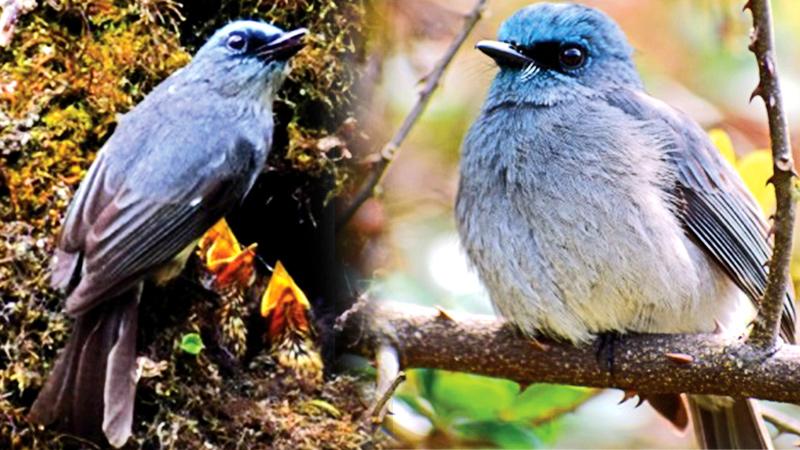
One of Sri Lanka’s unique habitat is cloud forests, also known as Montana rainforests and they host a variety of fascinating denizens.
For instance, highland endemic bird species have unique physical, biological and bio-geographical requirements that nowhere else can satisfy. These birds have evolved in tune with the specific high-altitudinal climate of the central hills of the island.
Cloud-stripping
These rare birds are only found in such cloud forests, where canopies have adapted to capture water from the clouds in a process known as cloud-stripping, which gives them far more water than they could obtain from rainfall.
 Among such bird species in Sri Lanka is the Dull-Blue Flycatcher, which inhabits the cloud forests of Horton Plains National Park (HPNP).
Among such bird species in Sri Lanka is the Dull-Blue Flycatcher, which inhabits the cloud forests of Horton Plains National Park (HPNP).
However, this species has been identified as ‘Near-Threatened’ (NT) by the International Union for Conservation of Nature (IUCN), meaning it faces the risk of extinction in the near future, even though it does not currently qualify for ‘Threatened’ status.
The IUCN periodically re-evaluates the status of such NT species, making it a national responsibility to carry out provisional ecological studies on such critical species to ensure their conservation.
Certain researchers have already sounded the warning that Sri Lanka’s endemic highland birds are placed at risk by the reduction of suitable areas for them to live.
Hill region
The Sri Lankan Dull-blue Flycatcher, scientifically known as Eumyias Sordidus, is an endemic, understory insectivorous bird that is restricted to a particular hill region (600m above sea level).
The species is unfortunately predicted to suffer an 80 percent reduction in habitable area by 2080. Therefore, to ensure the conservation of this feathered treasure, we need to conduct more in-depth studies to understand the resilience of the highland forests and their present distribution, population, foraging ecology and other ecological aspects.
Studies have highlighted how the lack of scientific data on avifauna poses a major problem to conserving bird species in Sri Lanka.
Recent studies also revealed that insectivorous birds in the tropics face far more risk from habitat fragmentation than their cousins.
The degradation, fragmentation and loss of habitat to human activity affect tropical biodiversity in all its forms, and the insectivorous bird species desperately require more understanding through informed study, considering that they are suffering a global decline due to reasons that are yet to be identified.
Researchers have also pointed out the numerous reasons why this species exclusively inhabits cloud forests, which include the canopy cover, ripened fruit, flowers, shrubs, ground and aerial insect availability, and wind speed.
They may also be partial to the cloud forest habitat for the cover it provides from the South West Monsoon’s strong winds. It is also learned that there may be local migrations happening during the periods of harsh climate.
 Dull-Blue Flycatchers hunt a wide range of invertebrate prey, including flying, ground and vegetation-dwelling species.
Dull-Blue Flycatchers hunt a wide range of invertebrate prey, including flying, ground and vegetation-dwelling species.
With such a diverse range of prey, as well as the use of multiple foraging techniques, the Dull-Blue Flycatcher shows a very flexible diet.
Current research shows that the species frequent the fruit of three plant species under the Rosaceae family, which is indigenous to Montana cloud forests. Additionally, they prefer moderate forest cover over dense forests.
Dull-Blue Flycatcher
According to studies, faecal samples of the Dull-Blue Flycatcher revealed remains of bees and wasps, dragonflies and damselflies, and adult lepidopterans and larvae, to a moderate level, while there have also been a few records of them capturing small amphibians to feed nestlings.
The species also participates in mixed-species foraging flocks, which see different species of birds forming flocks to gather food together.
However, the wide range of invertebrate prey consumed by the Dull-Blue Flycatcher leaves it rather vulnerable to accumulating environmental toxins.
Its prey includes strong-flying species which may come from relatively long distances away from the flycatcher’s sites. It also includes species of terrestrial and aquatic origin. Thus, pesticides and other potentially harmful compounds may be acquired from either of these resources.
Also, chemical toxins and exposure to pesticides and other harmful chemicals are particular threats at sites surrounded by intensive agriculture and along tea plantations, where this species was recorded in considerable numbers – a large number of pollinating insects in such grassland habitats are also a chief source of prey for the Dull-Blue Flycatcher.
Road kill
The Dull-Blue Flycatcher generally occupies road banks as their nesting sites.
Unfortunately, several instances of road kill have been recorded where fast-moving vehicles in the HPNP had collided with breeding individuals of the species, killing them in the process.
Especially the April New Year season, during which a large number of local and foreign tourists visit the park, is the main breeding season for the Dull-Blue Flycatcher in this habitat. The overlap of these two factors results in severe negative effects on the Dull-Blue Flycatcher.
Studies further prove that vehicles travel at considerably high speeds within the national park, result in the unfortunate deaths of any animal caught in their paths while returning to their nests for incubation or to feed their nestlings.
Fledglings are also directly impacted by these fast-moving vehicles, as nesting sites are often located beside the roads they frequent.
Having identified that Dull-Blue Flycatchers are already a near-threatened species, several recommendations and management implications for its conservation can be identified.
There are several white- coloured milestones beside the roads in the national park; these attract flying insects, as they strongly reflect sunlight.
Dull-Blue Flycatchers were seen sallying around these milestones to catch such prey, which increases the risk of them ending up in a road kill.
It is also suggested that the colour of these mileposts be changed to something darker, which would prevent this from occurring and minimise such fatalities.
As the high speeds of vehicles within the park have been identified as a main disturbance to the Dull-Blue Flycatchers, a speed limit can be enacted for vehicles inside the National Park and the areas surrounding the Montana cloud forests to avoid damaging the flycatcher, as well as other endemic species.
Also, since this species prefers to use road banks as nesting sites, it was noted that these are often disturbed by visitors.
It is, therefore, recommended that wildlife viewing opportunities be provided at safe distances from the nesting sites to avoid, or at least minimise, disturbance by visitors.
Visitors and photographers should be made aware about maintaining a safe distance from breeding sites as much as possible.
Certain incidents of breeding individuals being disturbed by the practices of the HPNP’s management have also been reported.
For instance, road bank clearance activities by workers to widen the roads in the national park directly impact breeding individuals, disrupting their nesting habitats and removing their perching plants and shrubbery near their nesting sites.
In this context, all authorities concerned should pay attention
to the matter, which would be of great benefit in preserving their natural nesting sites, especially if activities such as road bank clearances could be carried out at some time other than the breeding seasons of these birds.
